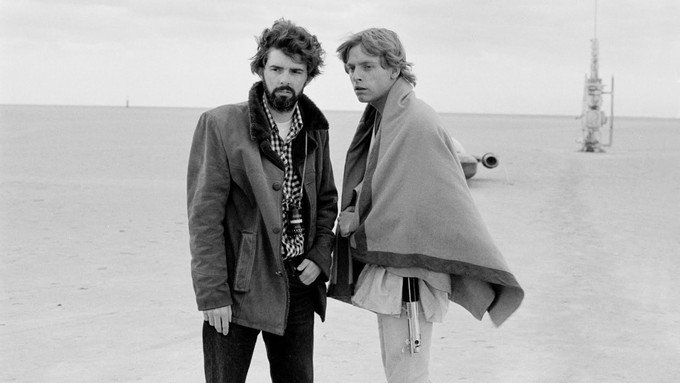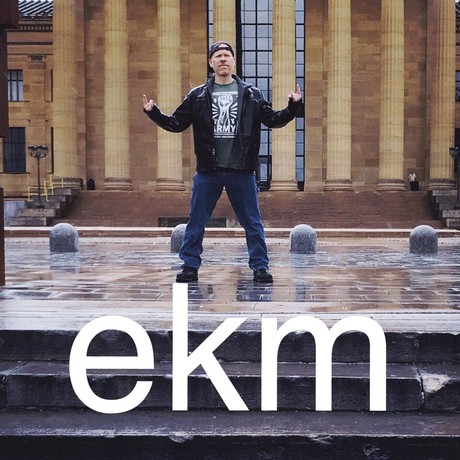
Fellow filmmakers, and film enthusiasts: please raise your glass in honor of George Lucas.
We all know the legend of the young director who challenged Hollywood with his unconventional ideas, and who ultimately beat them at their own game, throwing off the shackles of an oppressive, tyrannical studio system to build his own powerful empire. We’ve heard of his fall from grace and the tarnishing of his legacy, and we’ve celebrated his greatest creation’s triumphant return to social and entertainment relevancy. It’s the underdog tale of King Arthur, Frodo Baggins, Rocky Balboa, Elvis Presley, and yes: Luke Skywalker. It’s the Hero’s Journey, an archetype that this one storyteller managed to successfully harness and then use to spellbind three generations of viewers, all the while simultaneously walking the same mythical road in his own life. This is the story of George Lucas that will be told in countless biographies, documentaries, and inscribed in history books long after the departed becomes one with the Force.
But enough of all that.
Today I want to talk about what he’s done for me. For you. For the underdogs cut from his own cloth. Today I want to talk about how he’s opened the door for his followers to tell their own stories, make their own films, and, hopefully, someday influence audiences the way George Lucas influenced them. Nearly everything to do with how films are now made is the direct result of one man pushing technology forward, and changing the filmmaking paradigm forever. Let’s celebrate that.
A long time ago (2002), in a galaxy far, far away (North America), the second STAR WARS prequel, ATTACK OF THE CLONES, was released in the newfangled high definition video format. For the first time, a STAR WARS film wasn’t a “film” at all: Lucas had abandoned the traditional 70mm process and, working with the designers at Sony, created a next-generation camera that could do the impossible: it could emulate the look of film. To say this was the subject of intense industry controversy would be an understatement in the extreme.
At the time, I was a snotty film student shooting pretentious school projects, both on a 16mm Bolex, as well as the available video cameras of the day. We all know how technology dramatically changes every ten years; and in the case of video, we leaped from VHS to Hi-8 to Mini DV like a stone skipping across water. I remember it being a very big deal when I worked as a camera assistant on a no-budget Baltimore horror film, and the director showed up on set with a brand new a Canon XL2. It was a staggering thing to behold, because this camera could record images on digital video in twenty-four frames per second. Twenty-four frames per second. You could make an actual movie with this thing. It might not look like film, but we were getting there, slowly.
(NON-FILMMAKERS: Remember when you were a kid and drew stick men in the corners of your textbook, and when you flipped the pages, it looked like he was running and jumping? That’s how film works: the camera takes twenty-four photographs per second, and when played back at that rate, it creates the illusion of motion. Video cameras traditionally shot thirty frames per second, which is why, up to this point in the early 00s, video looked like “video” and film looked like “film.” They were very, very different.)
You have to understand: film is, was, and always will be cost-prohibitive. It’s expensive. For an independent filmmaker to plan a modest, low-budget horror film in Baltimore, it meant a budget roughly comparable to a new car…most of which would be spent on renting cameras, purchasing film stock, the subsequent lab fees, to say nothing of the transfer and duplication process. After all is said and done, you’ve spent it all before you’ve hired a single actor, paid for a single location, or figured out where the peanut butter and Diet Coke is coming from.
Trying to make a film was hard. It’s hard now, believe me; but at that time, unless you had a patron, a very rich (and very stupid) relative to exploit, or a winning lottery ticket, you could forget it. People went broke or to jail trying to finance even the lowest-budgeted feature.
So: video. Videotape existed as far back as the early 50s, and, from its inception, was typically used for news broadcast. Early attempts to transition the format into narrative programming was largely unsuccessful due to the simple fact that it looked like dog shit. Pornography eventually moved to tape in the 80s (much to many of the directors’ great chagrin) due to the needs of the genre (tits and Money Shots rather than misce en scene and expressionistic lighting); and Horror – always one half-step ahead of Porn in terms of respectability and profit margin -- dabbled with the format in classics like THE RIPPER and BOARDINGHOUSE. It speaks volumes that even Horror Movie producers realized that video was bad news and abandoned it before it had the chance to catch on.
But if video -- particularly with the development of digital tape -- served a master, then that master was the Apprentice: the film student. The novice. Film’s a nasty bitch to work with. Quite apart from the cost (even for 8mm, which has always looked like a series of out-of-focus smudges), what so many people take for granted these days when using their camera (or phone!) is that 1) you couldn’t see what you were filming in real time, because there was no such thing as “playback” on a film camera; and 2) you couldn’t record over what you’d shot. Film contains silver halides that, when exposed to light, literally burn the exposed field of view onto the stock; thus, if you ran out, or botched a take, too bad -- better buy some more reels, Spielberg.
Thus, digital video became a cost-effective way for both young filmmakers and those of experience, to make films for audiences willing to go along for the ride despite the clearly limited resources. It was a way to learn visual storytelling. To develop technique. Baltimore is known for John Waters and Barry Levinson; I see that and raise you Kevin Kangas, who shot the mini-DV feature FEAR OF THE CLOWNS that was easily one of the biggest success stories in our area, to say nothing of that Eduardo Sanchez guy who made a fairly popular movie about a witch, or something.
But here’s the thing: Ed was smart and embraced the limitations of video. He used the tools at his disposal in a self-reflexive way, accidentally creating what’s widely considered the first “found footage” Horror Movie to popularize the format. Other more traditional, narrative filmmakers had an uphill battle when working with video. Even if you had that XL2 with its 24fps capability, video was, well, video. If it wasn’t shot on film, it rarely received wide release, and even then was considered somehow illegitimate. Direct to video was once considered an embarrassment. To be a success, you needed to raise the funds for 16mm; good luck swinging for 35mm.
And editing…! Oh, you kids today with your MacBooks. If Orson Welles or Alfred Hitchcock had had even the most basic, pre-loaded software that’s installed on every base model at the Apple Store, then I promise you we’d all be living on other planets by now. Until you’ve edited physical film, you can’t ever complain about the annoying necessity of properly organizing your digital files. Back then, film was edited by threading the developed footage on a flatbed table-top device and then cut -- cut! -- at specific points, and then glued (!!) back together. All your takes would be hanging like coats on a rack, labeled and then handled as little as possible. Oh shit, you wanted that close-up to be half a beat longer? It sucks you cut where you did, because you destroyed the next frame in the sequence.
So let’s get back to George Lucas. Let’s talk about how he changed all of this.
What George Lucas gave us was the gift of non-linear editing through the introduction of Edit Droid, which was then advanced to the next level by later software developers. Film could now be transferred to video; video could now be assembled, out of order, on your computer using intuitive icons. This was expensive at first, and took a good decade to reach the prosumer market; but once it did, it didn’t matter what format you shot in: film, tape, or whatever -- the costs associated with transfer and post-production were suddenly reduced dramatically.
And then ATTACK OF THE CLONES happened. A big-budget, tentpole franchise film, shot on a video camera. This wasn’t digital tape: the high definition image, which, along with the frame rate approximation, image detail, and accompanying film lenses, was designed to replace the physical format forever. You shot it, and then you dumped it onto your computer. You could watch it back as soon as you captured it; you could delete it if you didn’t like it; and it was all kept as files on a hard drive.
The critics were calling for Lucas to be burnt at the stake for this heresy. So was I, to be honest. It felt like sacrilege. It felt like a betrayal of the sanctity of the art form. And let’s be honest: CLONES dated pretty quickly. The crew told nightmare stories of color issues that had to be resolved in post, resulting in twice as much time spent adding backgrounds and FX. What a dumb idea, we all said. Who wants to shoot on VIDEO?
Me. I did. I just didn’t know it yet. Because I was completely and totally wrong. The technology Lucas developed for ATTACK OF THE CLONES became the industry standard for Hollywood, largely eliminating film from the “film making” process; it also became available to consumers almost immediately. The first time I shot in high-def -- in the then-whopping 720p format -- I literally gasped. Here and now, I realized, I could make a movie that looked like a REAL MOVIE. I could shoot a feature-length narrative that wouldn’t require me to apologize to the audience, or to excuse the limitations of the image. People wouldn’t roll their eyes and laugh at my claim of being a filmmaker; the work would now prove my merit (or lack thereof), rather than the picture quality. Legitimacy was obtainable to anyone who would strive to use the tools now at their disposal.
When I shot my first feature, ROULETTE, I did something I never could have previously imagined: I purchased a camera, a laptop, and editing software, all on the same day, all on one credit card, and was then ready to shoot. No camera rentals; no film stock; no lab fees and processing; no post-production rentals of editing bays with tape and scissors and glue. I simply shot, imported, and edited. Color correction and computer animation were right there in my Final Cut package, in addition to my Skywalker Sound audio library, all of which represented the technological developments that began with the film that first inspired me as a child. And I marveled at what I could now do.
I could tell stories. I could reach audiences. I could make my dreams manifest, and then share them. I could truly become the independent filmmaker I had always dreamt of being. And I owed it to the man who was just like me until he took action, and paved the road for all to follow.
Thank you, George Lucas. Thank you for teaching me to dream, and for giving me the tools to live those dreams.
May the Force be with you.
Erik Kristopher Myers (aka ekm)
@ekmyers

